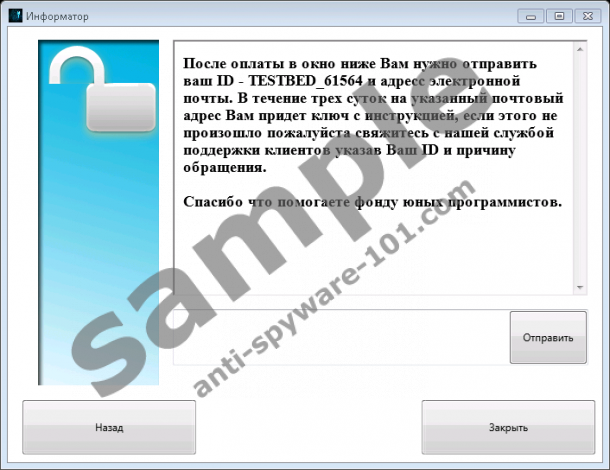What is Telecrypt Ransomware?
Telecrypt Ransomware is a malicious threat that targets your personal files to encrypt them and, eventually, demand a ransom in return for their release. This devious infection is targeted at users who live in Russia (possibly the neighboring countries where Russian is spoken as well), and, of course, all information it provides is in Russian. The primary source of communication for this threat is a three-part notification that is represented via a pop-up window. It does not lock the screen, and you can easily close it by clicking the “X” button on the top-right corner. According to the information in this notification, you need to pay a ransom to have your files back, and we will discuss this notification in depth further in this report. Right now, we need to tell you that you must focus on this threat completely. The longer you postpone dealing with it, the more trouble you might get yourself into. You can read this report to learn if you can delete Telecrypt Ransomware from your operating system yourself, as well as what you can do to potentially retrieve your personal files.


How does Telecrypt Ransomware work?
The infiltration of the malicious Telecrypt Ransomware is not unique, as it is most likely to be launched from a spam email attachment. Needless to say, the attachment file is not downloaded without your permission, and you have to do it yourself. Anti-Spyware-101.com researchers warn that opening spam emails from unfamiliar senders is always a bad idea, but you must realize this by now. Did you not know that the ransomware was executed as you opened the malicious file represented via a misleading spam email? That is very possible, considering that the infection does not introduce itself to you right away. In fact, if you realize that malware was launched, you might have time to stop it. The malicious Telecrypt Ransomware depends on Internet connection because it needs to record an ID generated for your PC, your computer’s name, and a generated key seed that is required for the creation of an encryption key. Also, the threat needs to download an encryption key, as well as the file that represents a ransom note. The infection was created in a way so that it exploits the Telegram (instant messaging service) channels and its application programming interface (API). If Internet connection is disabled, the threat cannot communicate with the C&C server and post a Telegram message with the information that cyber criminals need to initiate file encryption.
Unfortunately, it is unlikely that many users will realize the issue and disable Internet connection in time to stop Telecrypt Ransomware. If the encryption key is sent to the computer, your personal photos (all files with .jpeg and .jpg extensions), documents (all files with .doc, .docx, and .pfd extensions), and some other files will be encrypted. In some cases, the files might gain the “.Xcri’ extension, which might help identify the corrupted files, but our sample did not have this function. If you are having trouble identifying the corrupted files, open the file called “База зашифр файлов.txt”. This file is created by the ransomware to list all infected files and their locations. As mentioned previously, Telecrypt Ransomware also downloads a file to introduce you to the ransom demands. It is called “Xhelp.exe”, and it is downloaded to %TEMP%. Note that it is also copied to the Desktop, which means that you will need to remove it from both of these locations. Unfortunately, the threat uses a strong encryption algorithm, and you cannot restore your files by removing the ransomware itself. This is exactly why it leaves no other option but to pay the ransom of 5000 Rubles via Yandex or Qiwi.
How to delete Telecrypt Ransomware
Paying the ransom that Telecrypt Ransomware demands is not an option you should take lightly. For one, we cannot guarantee that your files would be decrypted if you paid it, which is something you need to think about if you have already made the decision to pay the ransom. So, what if you do not want to take the risk? The first thing you can do is check your backups to see if your personal files are backed up. If they are not, research legitimate third-party decryption tools to see if you can decrypt your files using them. Also, even if you get your files back, do not forget to remove Telecrypt Ransomware right away because you do not want it striking again! Overall, whether or not you retrieve your files – and we hope that you do – you have to erase the ransomware. You can erase this infection and set up full-time protection by utilizing trusted anti-malware software. Of course, you can also follow the manual removal instructions below.
Removal Instructions
- Locate the malicious launcher (think where you might have downloaded the corrupted spam email attachment).
- Right-click the malicious .exe file and choose Delete.
- Now, tap Win+E keys to access the Windows Explorer.
- Type %TEMP% into the bar at the top and tap Enter.
- Right-click the file named Xhelp.exe and choose Delete.
- Navigate to the Desktop.
- Right-click and Delete the copy of the Xhelp.exe file.
- Also, Delete the База зашифр файлов.txt file.
- Perform a full system scan to check if you have managed to erase the ransomware and to check for other potentially active infections.
tested removal of Telecrypt Ransomware*





0 Comments.